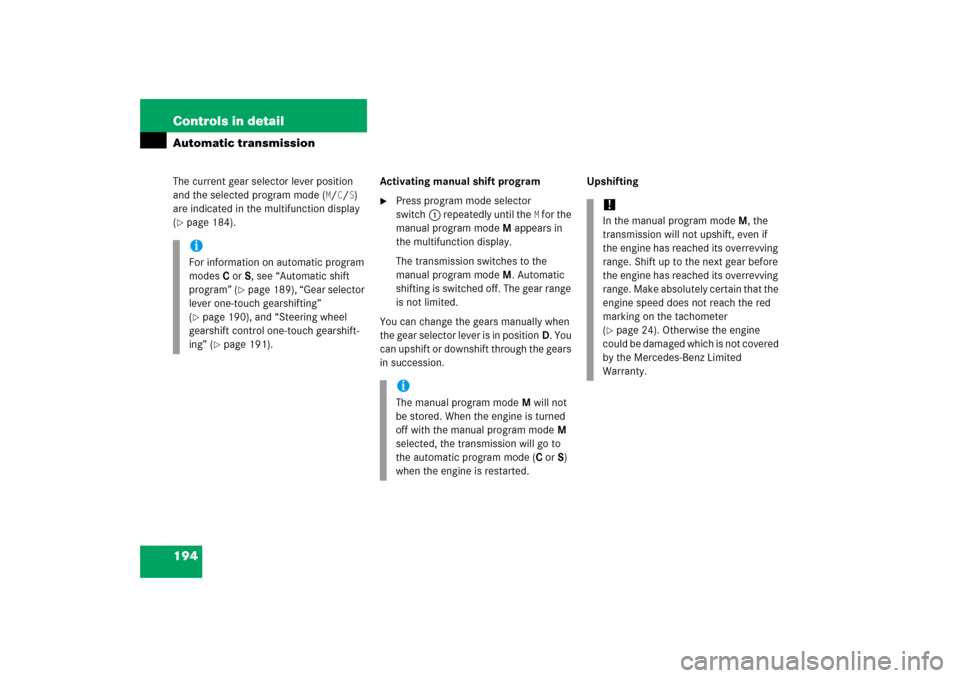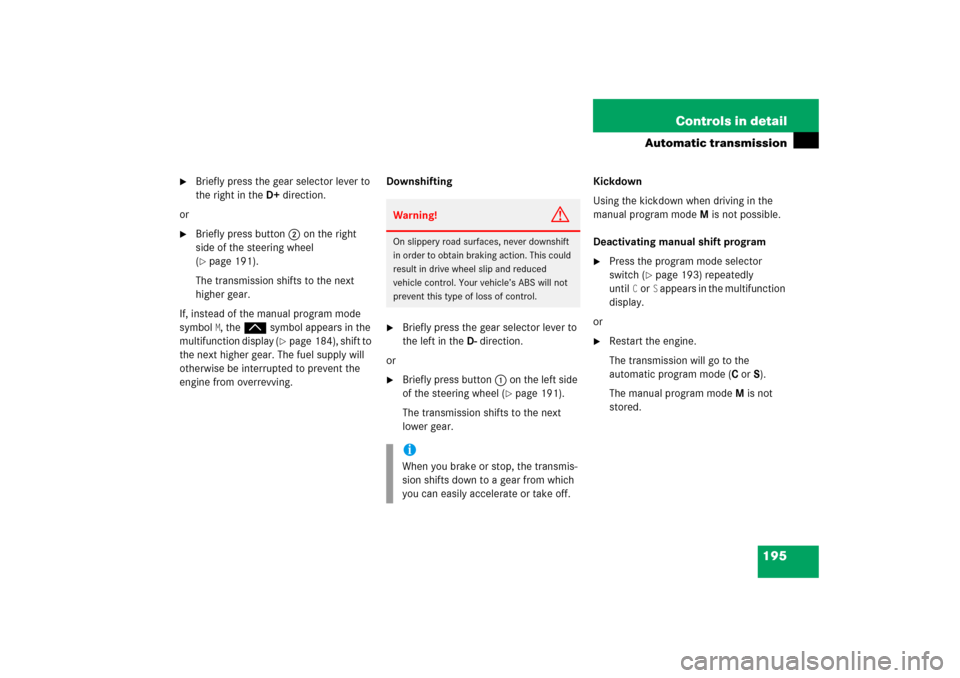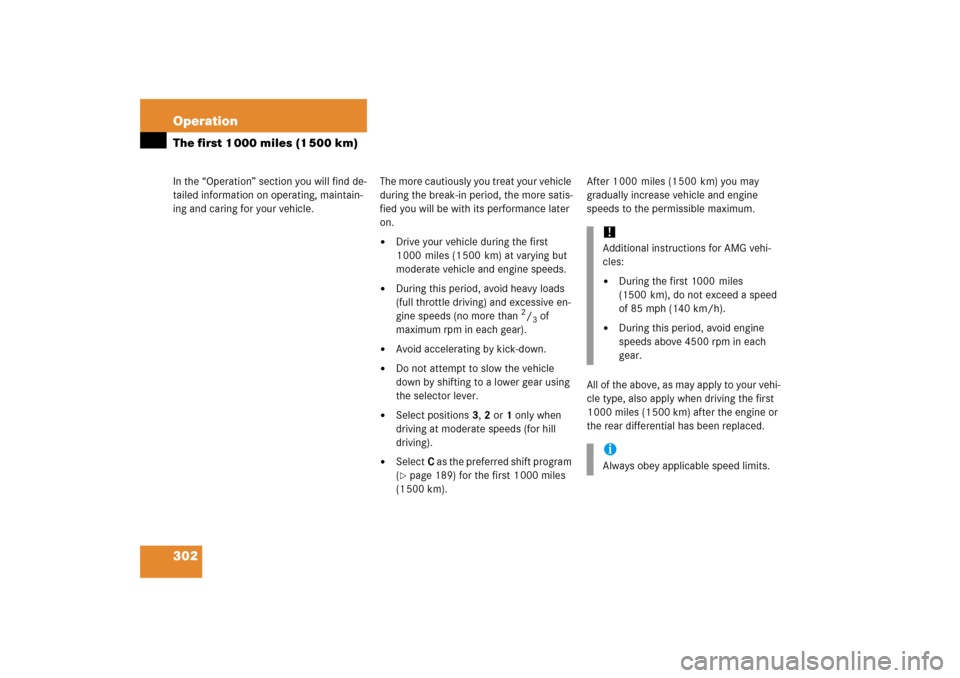Page 194 of 521

193 Controls in detail
Automatic transmission
Manual shift program E 55 AMG
In addition to the automatic shift
programC orS, your vehicle is equipped
with the manual shift programM.
In the manual program modeM,
system-controlled automatic gearshifting
is switched off and you need to change the
gears by manually upshifting or downshift-
ing using the steering wheel gearshift but-
tons to the left and right of the steering
wheel (
�page 191) or the gear selector
lever.The program mode selector switch is
located on the lower part of the center
console.
1Program mode selector switch
M Manual For manual gear shifting
C Comfort For comfort driving
S Sport For standard driving
!Allow engine to warm up under low
load use. Do not place full load on the
engine until the operating temperature
has been reached.
Shift into reverse gearR or parking
positionP only when the vehicle is
stopped.
Avoid spinning of a drive wheel for an
extended period when driving off on
slippery road surfaces. This may cause
serious damage to the drivetrain which
is not covered by the Mercedes-Benz
Limited Warranty.
Page 195 of 521

194 Controls in detailAutomatic transmissionThe current gear selector lever position
and the selected program mode (
M/C/S)
are indicated in the multifunction display
(
�page 184).Activating manual shift program
�
Press program mode selector
switch1 repeatedly until the
M for the
manual program modeM appears in
the multifunction display.
The transmission switches to the
manual program modeM. Automatic
shifting is switched off. The gear range
is not limited.
You can change the gears manually when
the gear selector lever is in positionD. You
can upshift or downshift through the gears
in succession.Upshifting
iFor information on automatic program
modesC orS, see “Automatic shift
program” (
�page 189), “Gear selector
lever one-touch gearshifting”
(
�page 190), and “Steering wheel
gearshift control one-touch gearshift-
ing” (�page 191).
iThe manual program modeM will not
be stored. When the engine is turned
off with the manual program modeM
selected, the transmission will go to
the automatic program mode (CorS)
when the engine is restarted.
!In the manual program modeM, the
transmission will not upshift, even if
the engine has reached its overrevving
range. Shift up to the next gear before
the engine has reached its overrevving
range. Make absolutely certain that the
engine speed does not reach the red
marking on the tachometer
(�page 24). Otherwise the engine
could be damaged which is not covered
by the Mercedes-Benz Limited
Warranty.
Page 196 of 521

195 Controls in detail
Automatic transmission
�
Briefly press the gear selector lever to
the right in theD+direction.
or
�
Briefly press button2 on the right
side of the steering wheel
(�page 191).
The transmission shifts to the next
higher gear.
If, instead of the manual program mode
symbolM, thep symbol appears in the
multifunction display (
�page 184), shift to
the next higher gear. The fuel supply will
otherwise be interrupted to prevent the
engine from overrevving.Downshifting
�
Briefly press the gear selector lever to
the left in theD-direction.
or
�
Briefly press button1 on the left side
of the steering wheel (
�page 191).
The transmission shifts to the next
lower gear.Kickdown
Using the kickdown when driving in the
manual program modeM is not possible.
Deactivating manual shift program
�
Press the program mode selector
switch (
�page 193) repeatedly
until
Cor
S appears in the multifunction
display.
or
�
Restart the engine.
The transmission will go to the
automatic program mode (C orS).
The manual program modeM is not
stored.
Warning!
G
On slippery road surfaces, never downshift
in order to obtain braking action. This could
result in drive wheel slip and reduced
vehicle control. Your vehicle’s ABS will not
prevent this type of loss of control.iWhen you brake or stop, the transmis-
sion shifts down to a gear from which
you can easily accelerate or take off.
Page 197 of 521
196 Controls in detailAutomatic transmissionEmergency operation (Limp Home Mode)
If vehicle acceleration worsens or the
transmission no longer shifts, the trans-
mission is most likely operating in limp
home (emergency operation) mode. In this
mode only second gear and reverse gear
can be activated.�
Stop the vehicle.
�
Move gear selector lever toP.
�
Turn off the engine.
�
Wait at least 10 seconds before
restarting.
�
Restart the engine.
�
Move gear selector lever to positionD
(for second gear) orR.
�
Have the transmission checked at an
authorized Mercedes-Benz Center as
soon as possible.
Page 303 of 521

302 OperationIn the “Operation” section you will find de-
tailed information on operating, maintain-
ing and caring for your vehicle.The first 1 000 miles (1 500 km)
The more cautiously you treat your vehicle
during the break-in period, the more satis-
fied you will be with its performance later
on.�
Drive your vehicle during the first
1 000 miles (1 500 km) at varying but
moderate vehicle and engine speeds.
�
During this period, avoid heavy loads
(full throttle driving) and excessive en-
gine speeds (no more than
2/3 of
maximum rpm in each gear).
�
Avoid accelerating by kick-down.
�
Do not attempt to slow the vehicle
down by shifting to a lower gear using
the selector lever.
�
Select positions3, 2 or1 only when
driving at moderate speeds (for hill
driving).
�
SelectC as the preferred shift program
(�page 189) for the first 1 000 miles
(1 500 km).After 1 000 miles (1 500 km) you may
gradually increase vehicle and engine
speeds to the permissible maximum.
All of the above, as may apply to your vehi-
cle type, also apply when driving the first
1 000 miles (1 500 km) after the engine or
the rear differential has been replaced.
!Additional instructions for AMG vehi-
cles:�
During the first 1000 miles
(1500 km), do not exceed a speed
of 85 mph (140 km/h).
�
During this period, avoid engine
speeds above 4500 rpm in each
gear.
iAlways obey applicable speed limits.
Page 306 of 521

305 Operation
Driving instructions
To help prevent brake disk corrosion after
driving on wet road surfaces (particularly
salted roads), it is advisable to brake the
vehicle with considerable force prior to
parking. The heat generated serves to dry
the brakes.
If your brake system is normally only sub-
jected to moderate loads, you should occa-
sionally test the effectiveness of the
brakes by applying above-normal braking
pressure at higher speeds. This will also
enhance the grip of the brake pads.
Refer to the description of the Brake Assist
System (BAS) (
�page 94).If the parking brake is released and the
brake warning lamp in the instrument clus-
ter stays on, there is a malfunction in the
electrohydraulic brake system (
�page 97)
or the brake fluid level in the reservoir is
too low.
Brake pad wear or a leak in the system may
be the reason for low brake fluid in the res-
ervoir.
Have the brake system inspected by quali-
fied technicians immediately. Contact an
authorized Mercedes-Benz Center.
All checks and service work on the brake
system should be carried out by qualified
technicians only. Contact an authorized
Mercedes-Benz Center.
Only install brake pads and brake fluid
recommended by Mercedes-Benz.
After hard braking, it is advisable to drive
on for some time, rather than immediately
park, so that the air stream will cool down
the brakes faster.
Warning!
G
Make sure not to endanger any other road
users when carrying out these braking ma-
neuvers.
Warning!
G
If other than recommended brake pads are
installed, or other than recommended brake
fluid is used, the braking properties of the
vehicle can be degraded to an extent that
safe braking is substantially impaired. This
could result in an accident.
Be certain to read and observe the warning
notices on brake pad replacement
(�page 400).!When driving down long and steep
grades, relieve the load on the brakes
by shifting into a lower gear to use the
engine’s braking power. This helps pre-
vent overheating of the brakes and re-
duces brake pad wear.
Page 310 of 521

309 Operation
Driving instructions
E320CDI
E 350, E 350 4MATIC
E 500, E 500 4MATIC
E 350 (Appearance Package*)
Your vehicle is factory equipped with
“H”-rated tires, which have a speed rating
of 130 mph (210 km/h).
An electronic speed limiter prevents your
vehicle from exceeding a speed of
130 mph (210 km/h).
E350(SportPackage*)
E500(SportPackage*)
E55AMG
Your vehicle is factory equipped with
“ZR”-rated tires, which have a speed rating
of above 149 mph (240 km/h).
An electronic speed limiter prevents your
vehicle from exceeding a speed of
130 mph (210 km/h).
E 55 AMG: An electronic speed limiter pre-
vents your vehicle from exceeding a speed
of 155 mph (250 km/h).E3504MATIC (Sport Package*)
1
E5004MATIC (Sport Package*)
Your vehicle is factory equipped with
“Y”-rated tires, which have a speed rating
of 186 mph (300 km/h).
An electronic speed limiter prevents your
vehicle from exceeding a speed of
130 mph (210 km/h).
Winter driving instructions
The most important rule for slippery or icy
roads is to drive sensibly and to avoid
abrupt acceleration, braking and steering
maneuvers. Do not use the cruise control
system under such conditions.
When the vehicle is in danger of skidding,
move gear selector lever to positionN. Try
to keep the vehicle under control by cor-
rective steering action.
1Not available in Canada.iFor information on speed ratings for
winter tires, see “Winter driving”
(�page 358).
For additional general information on
tire speed markings on tire sidewall,
see “Tire speed rating” (
�page 346).
iFor more information on driving with
snow chains, see “Snow chains”
(�page 359).
Warning!
G
On slippery road surfaces, never downshift
in order to obtain braking action. This could
result in drive wheel slip and reduced vehi-
cle control. Your vehicle’s ABS will not pre-
vent this type of control loss.
Page 325 of 521
324 OperationEngine compartmentE350
E500E320CDI
�
Unscrew filler cap1 from filler neck.
�
Add engine oil as required. Be careful
not to overfill with oil.
Be careful not to spill any oil when adding.
Avoid environmental damage caused by oil
entering the ground or water.
�
Screw filler cap1 back on filler neck.
For more information on engine oil, see the
“Technical data” section (
�page 484) and
(
�page 487).
Transmission fluid level
The transmission fluid level does not need
to be checked. If you notice transmission
fluid loss or gear shifting malfunctions,
have an authorized Mercedes-Benz Center
check the transmission.
!Excess oil must be siphoned or drained
off. It could cause damage to the
engine and catalytic converter (Gaso-
line engine) or oxidation catalyst
(Diesel engine) not covered by the
Mercedes-Benz Limited Warranty.